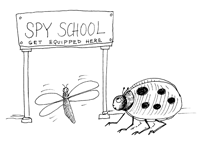STRANGE BUT TRUE- Enemy bugging: Military may tag along with insects

DRAWING BY DEBORAH DERR McCLINTOCK
Q. What's the U.S. Pentagon's latest version of "bugging" an enemy? –D. Rumsfeld
A. It's the first wireless flying-insect cyborg— a remote-controlled beetle borg by University of California at Berkeley engineers– which can rise, hover and fly on command, guided by a radio receiver that relays signals to electrodes connected to the insect's optic lobes and flight muscles, says Spencer Ornes in Discover magazine. Researchers recently demonstrated the bug-bot at a conference in Italy. With the mind of a machine and the nimble body of an insect, it may be the perfect scout: inexpensive, expendable and strong enough to carry payloads, such as a miniature reconnaissance camera.
The Defense Advanced Research Projects Agency (DARPA) is also sponsoring research on implanting insects with machinery during early life stages. Since butterflies can fly thousands of miles without feeding, a cyborg version might be perfect for long-range missions. Caterpillars might be modified to grow into adults that look like regular butterflies but have embedded wires and electrodes for flight control. Dragonflies, capable of 45 miles per hour, might take on high-speed missions. "And with a wingspan of about 10 inches, the moth 'Thysania agrippa' has caught DARPA's attention as a miniature cargo ship," says Ornes.
Q. "Your DNA and mine are 99.9% the same," the professor reported. Was he addressing his identical twin? His sibling? The guy next door? What if he had used the figure of 50%? –C. Sagan
A. Amazingly, he could have been talking to anyone, says Francis Collins of the Human Genome Project. Barely more than a century ago, few would have guessed that every cell nucleus in the human body contains the genetic master code for the entire body. It's as if every room in the Empire State Building had a book containing the architect's plans for the entire structure, says Hope College psychologist David G. Myers.
Each of our 46 chromosomes is composed of a coiled chain of the molecule DNA (deoxyribonucleic acid). Our genes, small segments of the giant DNA molecules, number 30,000 or so. Genetically speaking, every other human is close to being your identical twin, with people the world over sharing 99.9% of the common human DNA sequence. "At the DNA level, we are all part of one big worldwide family," Myers says.
Fact is, we aren't all that different from our chimpanzee cousins, with whom we share about 96% of our DNA sequence, he adds. And if the figure had been dropped to 50%, the speaker could have been addressing a banana in a fruit bowl, with whom we share half our genes!
Q. If you were an anthropologist studying kissing customs around the world, where might you be a bit squeamish about visiting? Hemophiliacs, take note. –A.P. Romanov
A. Natives of the beautiful Trobriand Islands of the South Pacific are far more open about showing affection than are most cultures, says College of Staten Island English teacher and attorney Michael Christian in The Art of Kissing. When nine or ten years old, they begin playing communal kissing games in large grass huts, with a couple of couples going in at a time. They rub each other's tongues and suck and bite the lower lips so vigorously these often bleed. Chin biting may follow, along with eyelash nibbling.
For this reason, short eyelashes are a status symbol— proof of being a sought-after romancer. "This is an actual kiss that is popular in the South Pacific. But I suggest you discuss it with your partner before trying it," says Christian.
~
Send Strange questions to brothers Bill and Rich at [email protected].
#